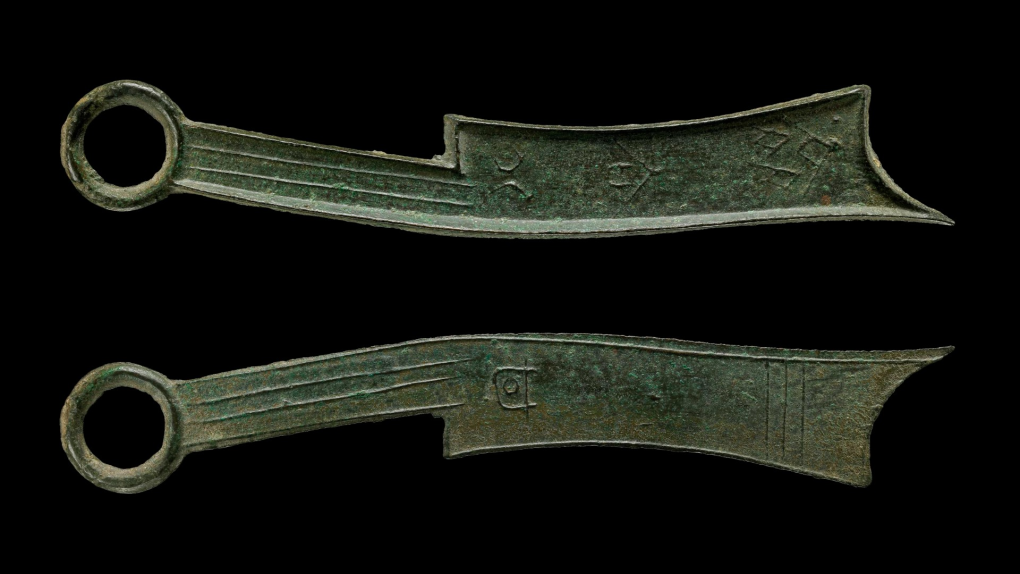
Invasive and toxic hammerhead worms make themselves at home in Ontario
Ontario is now home to an invasive and toxic worm species that can grow up to three feet long and can be dangerous to small animals and pets.
The ingredients in a 2,300-year-old ancient Chinese chemistry formula have finally been identified, revealing new secrets about metallurgy in ancient China.
The formula came from the Kaogong ji, a Chinese text dating back to 300 BC that's been called the "oldest known technical encyclopedia." The translated text of the formula reads, "The jin is divided into six, tin occupies one. This is the receipt for bells and tripod-vessels. The jin is divided into five, tin occupies one. This is the receipt for axes and hatchets."
For the past century, researchers have been unable to identify two of the key ingredients known as "Jin" and "Xi."
But now, researchers from the British Museum and the University of Oxford say the two mystery elements were most likely pre-mixed alloys. A paper outlining their findings is set to come out in October in the journal Antiquity.
“These recipes were used in the largest bronze industry in Eurasia during this period,” said Ruiliang Liu from the British Museum in a news release. “Attempts to reconstruct these processes have been made for more than a hundred years, but have failed.”
Previous studies have suggested that the two ingredients may have been copper and tin, but researchers say using copper and tin produced a metal that didn't match Chinese artifacts from the time.
Analyzing ancient Chinese coins, researchers concluded that this ancient metalworking process must have involved alloys rather than pure metals. The most likely combination was a copper-tin-lead alloy mixed with another copper-lead alloy.
“It indicates an additional step – the production of pre-prepared alloys - in the manufacturing process of copper-alloy objects in early China,” said Liu.
Liu says this discovery adds an "additional but previously unknown layer in the web of metal production and supply in China."
The researchers say their discovery allows a better understanding of ancient metalworking practices in China and offers an example of how science can help solve historical and linguistic mysteries.

Ontario is now home to an invasive and toxic worm species that can grow up to three feet long and can be dangerous to small animals and pets.
It's one thing to say you like Taylor Swift and her music, but don't blame CNN's AJ Willingham's when she says she just 'doesn't get' the global phenomenon.
The lawyer for a residential school survivor leading a proposed class-action defamation lawsuit against the Catholic Church over residential schools says the court action is a last resort.
A man has been handed a lengthy hunting ban and fined thousands of dollars for illegally killing a grizzly bear, B.C. conservation officers say.
Tornadoes wreaked havoc Friday in the Midwest, causing a building to collapse with dozens of people inside and destroying and damaging hundreds of homes, many around Omaha, Neb.
George Mallory is renowned for being one of the first British mountaineers to attempt to scale the dizzying heights of Mount Everest during the 1920s. Nearly a century later, newly digitized letters shed light on Mallory’s hopes and fears about ascending Everest.
South Africa marked 30 years since the end of apartheid and the birth of its democracy with a ceremony in the capital Saturday that included a 21-gun salute and the waving of the nation's multicolored flag.
Britney Spears has reached a settlement with her estranged father more than two years after the court-ordered termination of a conservatorship that had given him control of her life, their attorneys said.
A loud explosion was heard across Hamilton on Friday after a propane tank was accidentally destroyed and detonated at a local scrap metal yard, police say.

As if a 4-0 Edmonton Oilers lead in Game 1 of their playoff series with the Los Angeles Kings wasn't good enough, what was announced at Rogers Place during the next TV timeout nearly blew the roof off the downtown arena.
Mounties in Nanaimo, B.C., say two late-night revellers are lucky their allegedly drunken antics weren't reported to police after security cameras captured the men trying to steal a heavy sign from a downtown business.
A property tax bill is perplexing a small townhouse community in Fergus, Ont.
When identical twin sisters Kim and Michelle Krezonoski were invited to compete against some of the world’s most elite female runners at last week’s Boston Marathon, they were in disbelief.
The giant stone statues guarding the Lions Gate Bridge have been dressed in custom Vancouver Canucks jerseys as the NHL playoffs get underway.
A local Oilers fan is hoping to see his team cut through the postseason, so he can cut his hair.
A family from Laval, Que. is looking for answers... and their father's body. He died on vacation in Cuba and authorities sent someone else's body back to Canada.
A former educational assistant is calling attention to the rising violence in Alberta's classrooms.
The federal government says its plan to increase taxes on capital gains is aimed at wealthy Canadians to achieve “tax fairness.”
 Knife coins used in ancient China that were analyzed in the study. (The Trustees of the British Museum/CC BY-NC-SA 4.0)
Knife coins used in ancient China that were analyzed in the study. (The Trustees of the British Museum/CC BY-NC-SA 4.0)